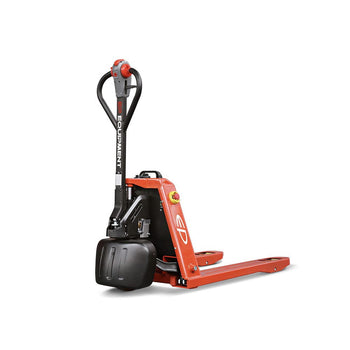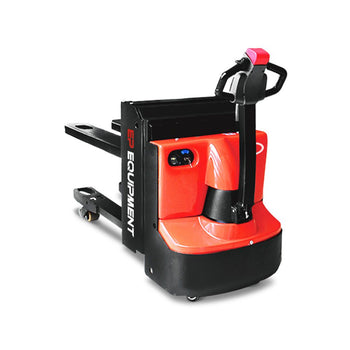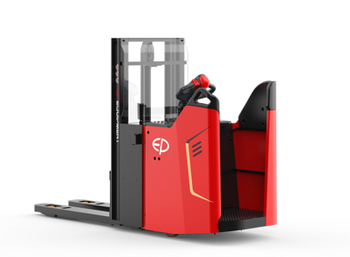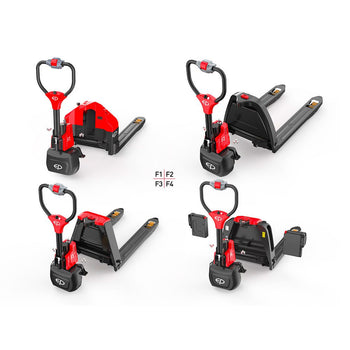Selecting the correct electric pallet truck isn’t as simple as picking the first machine that looks robust. Warehouses differ in size, aisle width, floor conditions and workload, and these factors all influence which model will deliver the best return on investment. This step‑by‑step guide explains how to match electric pallet truck types to your facility’s layout, load requirements and daily usage patterns. By understanding the criteria that matter most, you’ll not only improve efficiency and safety but also make informed purchasing or rental decisions that pay off over the long term.
Understand Your Warehouse Layout
Measure Aisle Widths and Turning Radius
Warehouses with narrow aisles demand equipment with a small turning circle. Short‑fork pallet trucks (around 800 mm) are designed for tight spaces and retail environments. Standard forks (approximately 1,150 mm) balance manoeuvrability and versatility and are the most common choice. Long forks (1,800–2,000 mm) are useful when you frequently handle oversized pallets or long goods. Measure the narrowest aisles and the tightest turning points in your facility. If your aisles are especially narrow, you may want a compact model such as iLift’s WPL201, which has a compact design and a 2 tonne capacity, making it suitable for tight warehouse environments.
Check Floor Surfaces
Electric pallet trucks rely on different wheel materials. Nylon wheels are rigid and suited to heavy loads on smooth floors. Polyurethane wheels provide quieter operation and are versatile for various applications but require slightly more effort when handling heavy loads. Rubber wheels grip well on wet or slippery floors and can reduce noise. Choosing the correct wheel type helps maintain stability, protects floors and reduces maintenance costs.
Evaluate Doorways and Loading Docks
Height restrictions and floor transitions also matter. Standard electric pallet trucks lift loads about 200 mm – enough to clear most pallet racking and lorry beds. If your warehouse requires stacking pallets at height or loading onto elevated platforms, consider high‑lift pallet trucks, which combine a pallet jack with a lift table and can raise loads higher (usually to around 330 mm).
Determine Your Load Requirements
Identify Maximum Weight and Load Distribution
Overloading any pallet truck shortens its lifespan and creates safety risks. Standard manual pallet trucks handle between 3,000 lb and 5,500 lb (≈1,360–2,500 kg), while electric pallet trucks typically support 3,000 lb to 8,000 lb (≈1,360–3,600 kg). Heavy‑duty models can handle up to 15,000 lb (≈6,800 kg). iLift’s EPL154 has a 1,500 kg capacity, while the EPL185 carries up to 1,850 kg. For even heavier tasks, the RPL series offers models with capacities of 2,000 kg, 2,500 kg and 3,000 kg. Always choose a truck with a higher rating than your heaviest load to maintain safety margins.
Consider Load Type and Pallet Size
If your business handles unusual loads or custom pallets, you may require a specialised truck. For example, adjustable‑fork trucks allow the operator to widen or narrow fork spacing for non‑standard pallets, and roll‑and‑reel trucks cradle cylindrical loads such as carpet rolls or wire coils. For standard Euro‑pallets (800 × 1,200 mm) and half‑pallets, conventional electric pallet trucks are sufficient. Measure the pallet dimensions and choose fork lengths accordingly to ensure the truck can fully support and lift the load.
Assess Frequency of Use
How many pallets do you move each day? Electric pallet trucks excel in high‑intensity applications because they reduce operator fatigue and speed up material handling. Walk‑behind models like the EPL1531 are designed for busy warehouses and feature a plug‑and‑play battery that enables continuous operation for multiple shifts. If you need to transport goods across longer distances within a warehouse or require operators to ride rather than walk, consider ride‑on trucks such as iLift’s RPL series; they include electric power steering for easier manoeuvring over medium to long distances.
Decide Between Manual and Electric
Manual pallet trucks are inexpensive and simple to use, making them suitable for light, occasional tasks in small warehouses or retail shops. Electric models cost more up front, but they provide significant benefits:
-
Reduced strain on employees – Electric controls eliminate the need to pump the handle or push heavy loads, reducing risk of musculoskeletal disorders.
-
Ease of manoeuvrability – Operators steer with a tiller that controls both travel and lift, making it easy to position loads precisely.
-
Rapid learning curve – The intuitive controls mean staff can be trained quickly.
-
Cleaner and quieter operation – Electric trucks emit no fumes and generate less noise than internal‑combustion equipment.
For high‑throughput warehouses, the productivity gains usually justify the higher purchase price. iLift’s range includes both lead‑acid and lithium‑ion‑powered models. Lithium‑ion batteries (used in the EPL154/185 and EPL1531) deliver longer runtimes, fast opportunity charging and minimal maintenance, ensuring the truck is always ready for action.

Examine Battery Technology and Charging Needs
Lead‑Acid vs. Lithium‑Ion
The battery influences not only run time but also overall lifetime cost. Lead‑acid batteries are cheaper but require regular topping up with distilled water and take longer to charge. For example, iLift’s WPL201 uses a 24 V lead‑acid battery and is suitable for standard warehouse applications with moderate duty cycles. Lithium‑ion batteries, by contrast, are maintenance‑free, support rapid charging and deliver consistent power output. iLift’s EPL154/185 and EPL1531 models use lithium‑ion technology, with plug‑and‑play batteries that can be swapped out quickly to keep the truck running through multiple shifts. When comparing battery technologies, consider:
-
Charging infrastructure – Lithium‑ion chargers are often smaller and can be located at convenient points in the warehouse. Lead‑acid chargers require dedicated charging rooms with ventilation.
-
Downtime – Lithium‑ion batteries can be opportunistically charged during breaks, reducing downtime. Lead‑acid batteries typically need several hours of charging and cooling.
-
Environmental impact – Lithium‑ion batteries are sealed and spill‑proof, whereas lead‑acid batteries contain hazardous materials that require careful handling.
Voltage and Power
Higher voltage batteries provide greater torque and travel speed. iLift’s WPL201 uses a 48 V brushless DC motor to offer enough power for challenging gradeability or ground clearance requirements. The RPL series uses robust motors and electric power steering to handle heavy loads and long distances with minimal operator effort. Ensure the motor and battery combination matches the grades, slopes or ramps in your facility.
Consider Ergonomics and Safety
Operator Comfort
Ergonomics directly affect productivity and injury rates. Look for an ergonomic handle with easy‑to‑reach controls that reduce wrist strain. The EPT WA series features an ergonomic tiller and a compact design that makes manoeuvring in tight spaces comfortable and reduces operator fatigue. Ride‑on models should provide cushioned platforms or seats and adjustable steering for various operator heights.
Safety Features
Key safety features include:
-
Emergency stop and brake position – iLift’s EPL1531 has a control handle that can be set to a brake position for hazardous situations.
-
Stabilising wheels – Newer models such as the EPL154/185 incorporate stabilising wheels for greater stability during turns.
-
Load backrest and fork tip visibility – A load backrest prevents cargo from sliding backwards, while tapered fork tips and built‑in lights improve visibility when entering pallets.
-
Non‑marking tyres – If your warehouse has sensitive flooring, choose trucks with non‑marking tyres to prevent damage.
Safety also depends on proper training. Operators should be familiar with the machine’s controls, load capacity and operating environment. Regular inspections of the hydraulic system, wheels, forks and battery condition prevent accidents and prolong equipment life.
Match the Truck to Your Application
Short‑distance Picking and Dock Work
For loading and unloading lorries or moving pallets over short distances, walk‑behind electric pallet trucks like the EPL154/185 or EPL1531 are ideal. They provide enough power to handle heavy loads while remaining easy to manoeuvre. The EPL154/185 models deliver capacities of 1,500 kg and 1,850 kg, respectively, and feature Li‑ion batteries with faster travel speeds and stronger motors.
Narrow‑Aisle or High‑Density Storage
If your warehouse has aisles narrower than 2 m, look for compact trucks with tight turning radii. The EPT WA series can manoeuvre through aisles and doorways as narrow as 1,815 mm and handle pallets up to 800 × 1,200 mm. Its ergonomic handle and durable wheels allow it to operate both indoors and in light outdoor settings. This makes the WA series an excellent choice for high‑density storage or logistics operations where space is at a premium.
Long‑Distance Transport
When operators need to move pallets across long warehouse runs, ride‑on models improve efficiency. iLift’s RPL201/251/301 series offers capacities ranging from 2,000 kg to 3,000 kg. The key difference between the models is load capacity and size; the RPL201 suits lighter loads, the RPL251 handles medium loads, and the RPL301 is best for heavy loads. These ride‑on trucks include electric power steering for effortless manoeuvring and are designed for medium‑to‑long distance transport tasks.
Versatility and Customisation
If your operation handles diverse tasks, choose a versatile model. iLift’s F Series emphasises a configurable design that balances simplicity with the ability to meet varying market demands. It is primarily designed for indoor use and offers excellent manoeuvrability in tight spaces. Because it requires low maintenance, routine checks of the battery and hydraulic system suffice to keep it running. For general warehouse applications where you need one truck to handle multiple duties, the F Series provides a good compromise.

Budget Considerations and Total Cost of Ownership
Upfront Cost vs. Lifetime Savings
Electric pallet trucks generally have higher initial prices than manual units, reflecting the cost of the battery, motor and electronic controls. However, the total cost of ownership often favours electric models because they:
-
Increase throughput – Faster travel and lift speeds enable operators to move more pallets per shift.
-
Reduce labour costs – Less physical strain means fewer injuries and better retention.
-
Lower maintenance – Lithium‑ion systems require little maintenance and last thousands of charge cycles.
-
Improve safety – Fewer accidents and product damage reduce downtime and replacement costs.
Although iLift lists prices for some forklift models (for example, the EP EFS151), pallet truck prices vary depending on capacity and battery technology. For an accurate estimate, contact our team for a quote or explore rental options if you want to test a model before committing to a purchase.
Rental vs. Purchase
Renting allows businesses to access high‑quality equipment without large capital expenditures. iLift offers flexible rental packages with no hidden fees and provides quick booking and clear pricing. If your needs are seasonal or project‑based, renting may be more economical. Purchasing is advantageous when the truck will be in constant use and offers better long‑term value. Evaluate your business’s cash flow and operational demands when making this decision.
Steps to Choosing the Right Pallet Truck
-
Analyse your warehouse layout – Measure aisle widths, turning radii and doorway clearances. Choose compact models for narrow aisles and longer forks for oversized loads.
-
Determine maximum and average load weight – Select a truck with at least a 10 % higher capacity than your heaviest load.
-
Identify your usage patterns – For high‑volume operations, invest in electric models; for occasional use or very small facilities, manual models may suffice.
-
Select the appropriate battery technology – Opt for lithium‑ion for longer runtimes and opportunity charging, or lead‑acid for lower upfront cost.
-
Match the truck type to the application – Walk‑behind for short distances, ride‑on for long distances, and specialty trucks for unusual loads.
-
Check ergonomics and safety features – Ensure the truck has ergonomic handles, stabilising wheels, and emergency brakes.
-
Review maintenance and support – Consider service contracts, warranty terms and the availability of spare parts. iLift provides service contracts and a five‑year battery warranty to minimise downtime.
-
Compare purchase and rental options – Evaluate total cost of ownership and consider renting if you need flexibility.
-
Request a demonstration – Always test a pallet truck under realistic conditions to ensure it meets your expectations.
We are here to help
iLift supplies a broad range of EP electric pallet trucks equipped with lithium‑ion and lead‑acid batteries. Models such as the EPL154/185 and EPL1531 feature plug‑and‑play lithium‑ion batteries, compact designs and capacities up to 1,850 kg. The EPT WA series offers 2 tonne capacity, ergonomic controls and the ability to navigate aisles as narrow as 1,815 mm. For ride‑on capability, the RPL series delivers capacities up to 3,000 kg with electric power steering. iLift stands behind its equipment with pre‑delivery inspections, flexible service contracts, five‑year battery warranties, and the option to rent or purchase. Whether you need a single truck or an entire fleet, the iLift team can help you select, finance and maintain the right solution.
Ready to improve your material handling efficiency?
Explore iLift’s full range of electric pallet trucks and speak with an expert about which model will best suit your warehouse. Contact our sales team at 01600 800 800 or email enquiry@ilift.co.uk to request a demonstration, receive a tailored quote or arrange a rental. Harness the benefits of lithium‑ion technology and choose a pallet truck that works as hard as you do.





